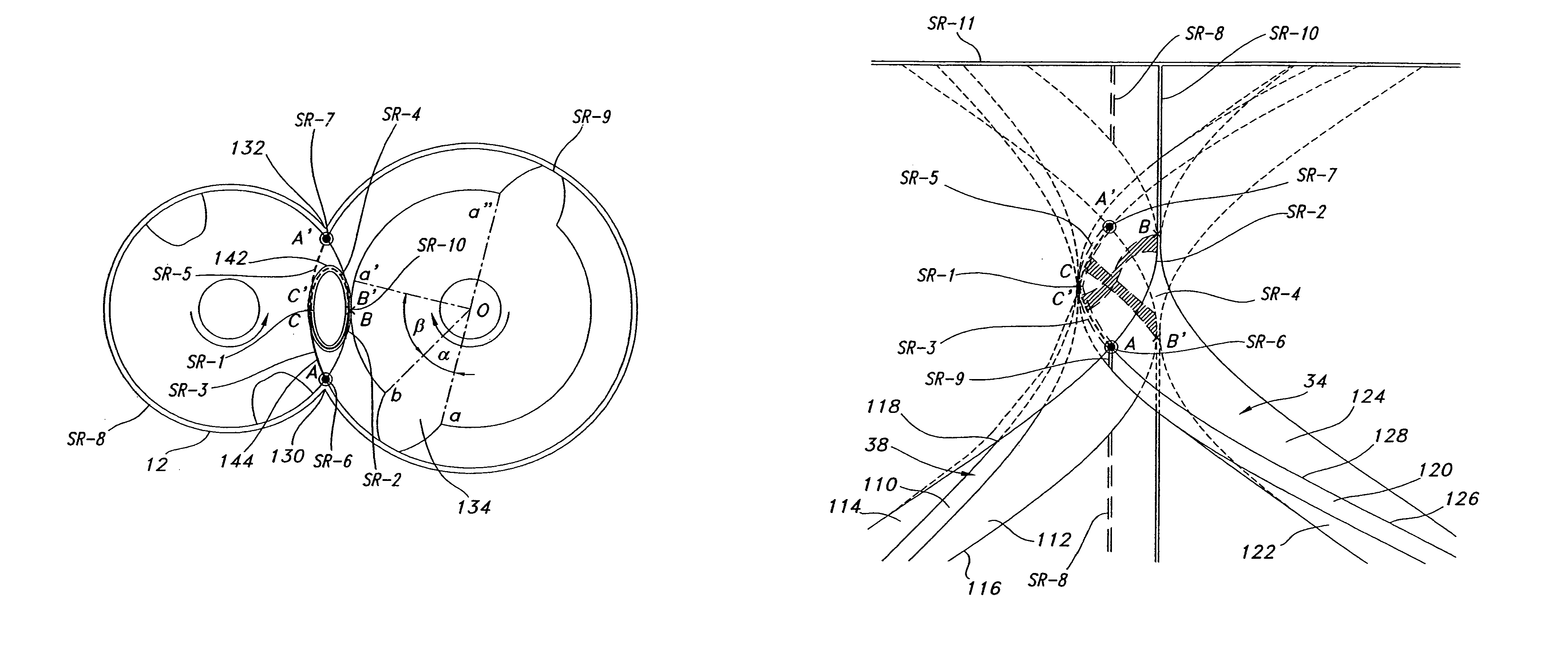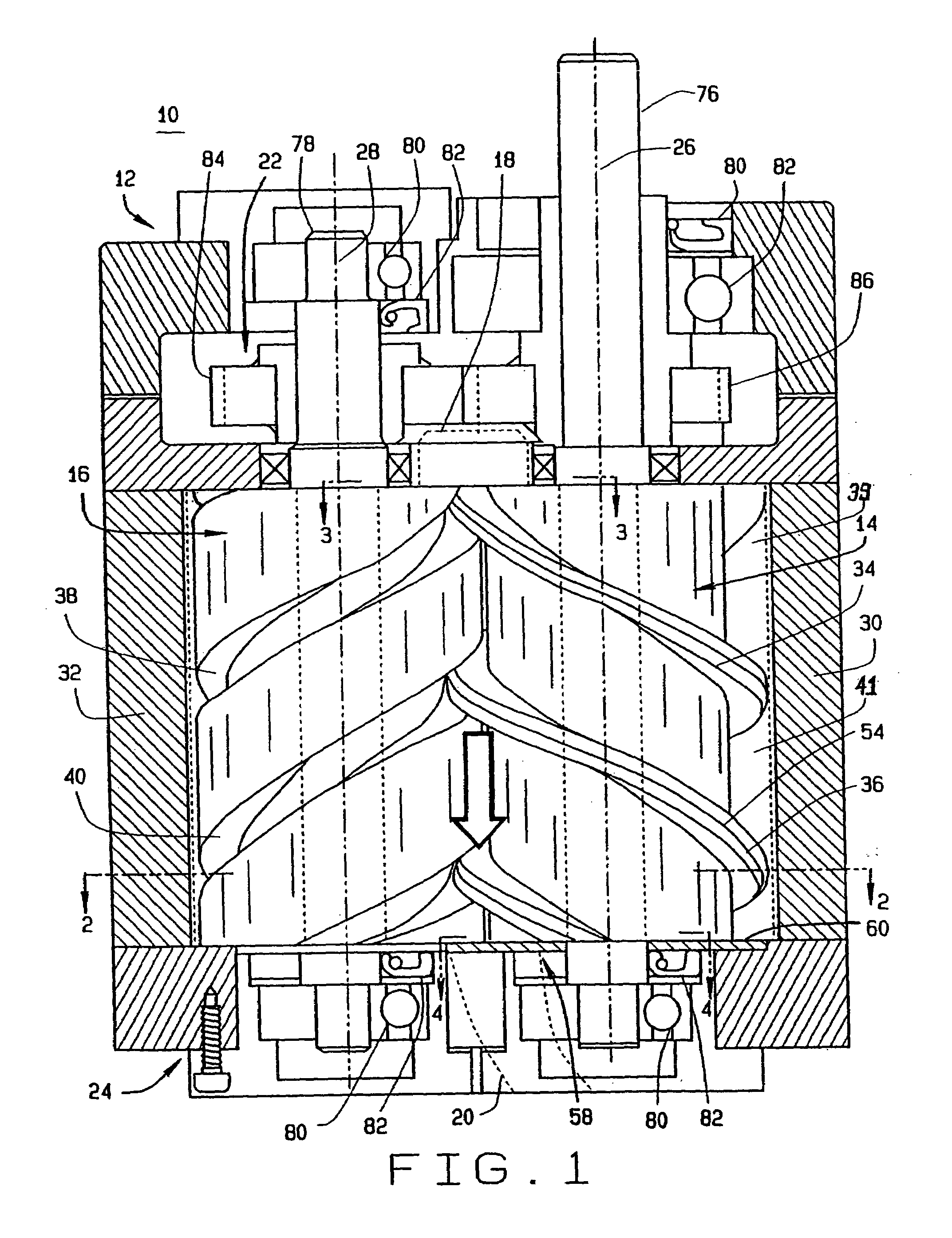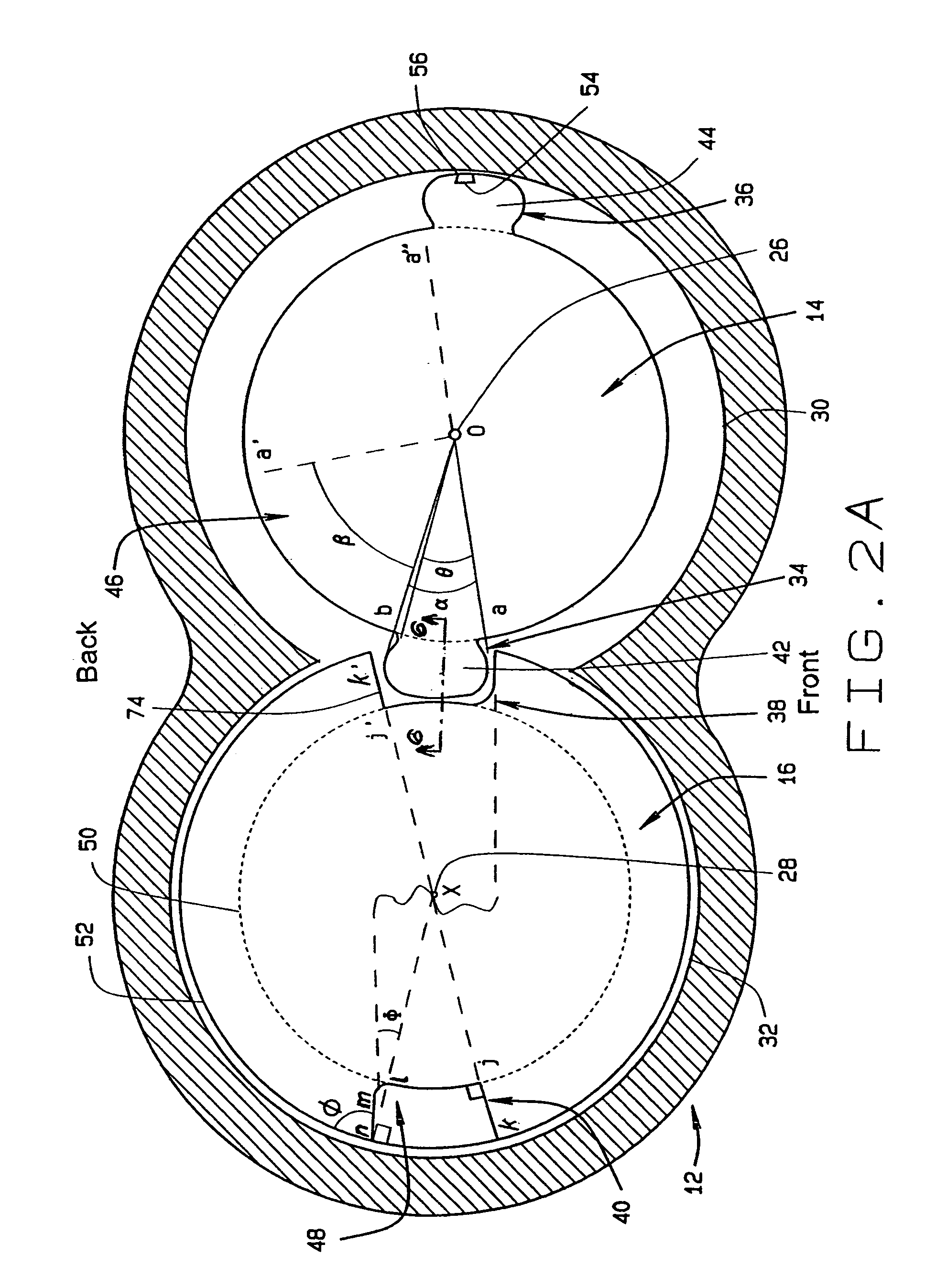However, an
involute for a
gear tooth is primarily designed for strength and to prevent lock-up as teeth mesh with each other and are not necessarily optimum for the circumferential sealing of rotors within a housing.
Although adiabatic efficiency and
volumetric efficiency are different performance parameters, a number of screw rotor features can affect both of these efficiencies.
Such performance characteristic could be caused by
thermal expansion of the rotors,
machining tolerances, and even the material properties of the rotors, which can result in intermittent contact between the rotors and the sides of the housing or between the rotors themselves.
Such inherent leaks would occur even when the tolerances are perfected, i.e., zero
thermal expansion, perfect
machining tolerances, and a perfectly smooth finished material.
These leak pathways result in losses that adversely affect both the thermodynamic efficiency and the
volumetric efficiency of screw rotors.
Accordingly, leak pathways are some of the most important losses to consider for the performance of screw rotors when the screw rotors are being designed because these losses negatively affect both thermodynamic efficiency and
volumetric efficiency.
In fact, it is a common belief by the designers, manufacturers and users of screw rotors that it is impossible to eliminate some of the leaks in a screw rotor
system.
However, there remains a need for better methodologies for designing screw rotor profiles that account for
machining constraints,
thermal expansion and material tolerances, as well as mechanical efficiencies, and that also eliminate any inherent leak pathway from the
design process, even though it is presently considered impossible.
In comparison, when the leak pathway remains an inherent feature of the rotor profiles, the designer must first minimize the leak pathway using more complex designs that are harder and costlier to manufacture and then changes to the design are limited by the complexity of the design, machining and other manufacturing capabilities and thermal expansion requirements.
Leak pathways are generally caused by internal leakage between the rotors and the housing and between the rotors themselves and result in volumetric losses and thermodynamic losses due to recirculation of the
working fluid within the rotors.
In this transition, a gap is formed between the meshing threads and the housing, causing leaks of the
working fluid through the gap in the sealing surfaces and resulting in less efficiency in the rotor
system.
A number of arcuate profile designs improve the seal between rotors and may reduce the gap in this transition region but these profiles still retain the characteristic gear profile with tightly spaced teeth around the circumference, resulting in a number of gaps in the transition region that are respectively produced by each of the threads.
Some pumps minimize the number of threads and grooves and may only have a single acme thread for each of the rotors, but these threads have a wide profile around the circumferences of the rotors and generally result in larger gaps in the transition region.
Until now, screw rotor expanders, compressors and pumps have had similar fundamental flaws.
While it is clear from the images of the Krigar design that there definitely were sealing issues, especially between the threads and the grooves, and Krigar appears to be more directed to radial flow, the Lysholm conclusion that the Krigar design could not perform any compression with only the 2×2 configuration is flawed.
Additionally, since the rotor profiles are designed according to the traditional gear profile
design methods, these rotors are usually limited in the types of arcuate lines that can be used to effect the seal.
When the third dimension is accounted for in prior art design methodologies, it is typically limited to standard
helix angle definitions that have been developed for ordinary screws, i.e., fastening screws.
Such an approach fails to truly account for and does not take
advantage of the third dimension.
The planar design methodologies fail to apply the function of the
helix angle with respect to the
radius, resulting in the profiles with leak pathways discussed above.
In one aspect, the planar
design methods are unnecessarily restrictive because they only take
advantage of two-dimensional space to overcome the limitation that the threads must not lock-up in the grooves.
In another aspect, the planar
design methods are not restrictive enough because when the profiles are expanded into three-dimensional space, the profiles have three-dimensional leak pathways.
More generally, similar fundamental flaws in the prior art designs and their respective methodologies can be traced back to their failure to accommodate for and use the additional degree of design freedom provided by the third dimension.
Such rounded edges and ridges cannot possibly seal between the rotors and the housing when the thread and groove begin meshing with each other.
In some designs, the gap can be even larger, such as in screw rotors that have a different number of threads and grooves, i.e. not the same number of threads as grooves, and the loss in pressure to the low pressure side causes the thermodynamic efficiency to drop.
Additionally, by failing to take
advantage of the third dimension in the design of the thread and groove, the prior art design methods have failed to optimize the basic screw
rotor design or improve the screw rotor efficiencies to their full potential.
In an attempt to compensate for this unwitting failure to take advantage of the third dimension, the prior art designs have increasingly become more complex over the years without offering much improvement in the thermodynamic efficiency of the rotor
system.
As evidence of the failure to appreciate volumetric design methodologies as an alternative to traditional gear design methods combined with traditional
fastener screw methods, these planar design methodologies increasingly led to these more complex screw rotor designs as machining and other manufacturing methods improved over the years and permitted the increasing complexity.
Additionally, these increasingly complex screw rotor profile designs, which need such improved manufacturing methods, support the conclusion that the failure to take advantage of the third dimension has been an unwitting failure because volumetric design methodologies actually permit much more simplified designs which can be less complex to manufacture than profiles created using the planar design methodologies.
 Login to View More
Login to View More  Login to View More
Login to View More 


